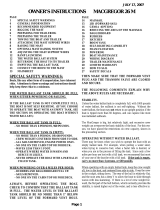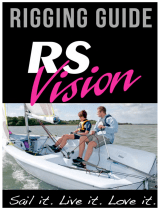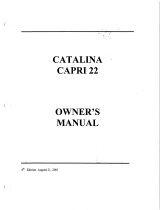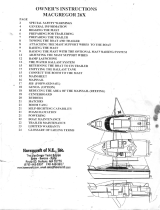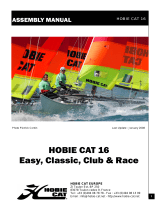
rope, knots and wires. It is very important to mark the jib
halyard at the setting what seems fast. To get this set-
ting will mean time on the water as there is no standard
position. To find the setting simply try to sail against
other people and see where it is the fastest. To adjust
on the water stop the boat and change the halyard posi-
tion by only 2.5cm at a time. This control makes such a
big difference adjustments over 2.5cm will mean you
can go from one extreme to another. Adjust tighter or
looser by the following:
If you are overpowered, cant pull the mainsheet ‘block
to block’, having difficulties holding the boat flat upwind,
or seem very high and slow: LET OFF THE JIB HA-
LYARD
If you are underpowered, very easy to pull the main-
sheet ‘block to block’, dragging in the water or difficult to
trapeze, or seem to have no height: PULL ON THE JIB
HALYARD
****************************************************
Remember only adjust at 2.5cm at a time
****************************************************
Trapeze Height
This varies greatly on what kind of Trap Harness you
have and how loose you wear it. But the idea is to be as
low as possible. In the last race of the World Champion-
ship I think it must have been the highest I have ever
trapezed in my life! As a general rule my crew’s trapeze
hook at the bottom most point is around 10cm below the
side bar. The skipper is a little higher, around the same
level as the top of the side bar, so they can see over the
top of the crew.
Mainsail Luff Tension
Again not something I really adjust. I never adjust it du-
ring a race and the only time I ever pull the Cunningham
on is if the wind is very, very strong. So where do I have
it? With wind from 5- 20 knots the bottom of the goose-
neck is 6cm above the black band sticker on the mast. It
works for me here every time. Over 20 knots we use
more tension, perhaps to halve that distance.
Rudder Alignment
As I am a little lazy and disorganised when it comes to
regatta’s tape measures are not something I normally
carry around. I find simply sighting down the hull, with
the rudders down from the back of the boat adequate.
Just line up the rudders with the bow of the boat. Re-
member I am generally sailing around with one rudder
up so having them not perfectly aligned doesn’t make
any difference.
If you are a bit of a technical freak use this method.
Measure half way down both rudder blades on both the
leading and trailing edges make a mark with a pencil at
this point. Starting on the trailing edge get the crew to
hold the ‘dumb’ end of the tape measure on the oppo-
site blade. Measure the distance between the two trai-
ling edges. Then do the same thing for the leading edge
of the blades. From memory the difference should be
about 5mm narrower on the front edge.
Once Rigged
Remember the less stuff you carry around the better. So
cut any excess lines and over length sheets that you
don’t need.
On the Water
Always try to get a good length windward/ leeward leg in
before the stat of the race. 5 minutes on both tacks is
very important to test speed and make sure all is ok.
I run through a small check- list to make sure the boat is
ok:
Rig Tension Firm as possible
Trapeze Height Low as possible depending on
waves
Cunningham Pulled to the correct mark
Up Wind:
Double Trapeze Conditions
Remember the Jib Halyard tuning talked about earlier.
You must adjust the jib halyard to suit for the conditions
but I generally sail with the sail setting all the time.
Ideally the main traveller should move between the cen-
ter (for the lightest lull in the wind) and slightly past the
foot-strap (for the strongest gust). Try to always keep
the mainsheet ‘block to block’ when sailing up wind.
This is the ‘double trapezing upwind range’ for the Ho-
bie 16. You want to set the boat up to do this.
The Jib Cars should be out at least half way to the front
corner casting and the jib should be sheeted very
tightly. Be careful to ease the jib sheet when the breeze
drops as the jib is very big and can easily touch the
mast and close the slot.
Crew position on the boat. I generally stand quite a long
way back on the side bar. My back foot in flat water is
around 15cm from the back of the side bar with my crew
as close as possible. As the wind increases we move
back to the corner casting, and sometimes in big waves
I put on foot on the hull and my front foot on the side
bar.
No Trapeze Conditions
For light wind when you cannot double trapeze it is sim-
ply a matter of steering and trimming well. Very different
set-ups work in light wind, but the team that can trapeze
first has the most power and generally speed. In the
lighter wind getting the mainsheet ‘block to block’ is not
possible so I ease the main traveller out 15cm from the
middle and concentrate on trimming and steering well
and pay lots of attention as to not over-sheet.





